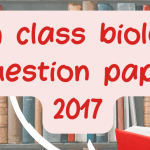BDS question paper 2019 offers essential insights into the types of questions students can expect during their exams. Covering all subjects, these questions and answers provide a comprehensive understanding of the syllabus and concepts. This guide serves as an educational tool for students preparing for their BDS examinations effectively.
General Anatomy
Question: What is the composition of the human skeletal system?
Answer: The human skeletal system consists of 206 bones, including axial and appendicular bones that support and protect the body.
Question: What are the types of joints in the human body?
Answer: The three main types of joints are fibrous, cartilaginous, and synovial joints.
Question: Describe the structure of a long bone.
Answer: A long bone has a diaphysis, epiphyses, and metaphysis, with a medullary cavity and periosteum covering it.
Question: What are the functions of cartilage?
Answer: Cartilage provides support, reduces friction in joints, and acts as a shock absorber.
Question: How many vertebrae are there in the vertebral column?
Answer: The vertebral column has 33 vertebrae, divided into cervical, thoracic, lumbar, sacral, and coccygeal regions.
Question: Define the term “osteogenesis.”
Answer: Osteogenesis is the process of bone formation during growth and healing.
Question: What is the significance of the hyoid bone?
Answer: The hyoid bone supports the tongue and helps in swallowing and speech.
Question: Name the bones that form the human skull.
Answer: The human skull consists of cranial bones (8) and facial bones (14).
Question: What is the function of red bone marrow?
Answer: Red bone marrow produces red blood cells, white blood cells, and platelets.
Question: Describe the scapula’s anatomical features.
Answer: The scapula is a triangular, flat bone with a spine, acromion, glenoid cavity, and coracoid process.
Question: What is the role of synovial fluid?
Answer: Synovial fluid lubricates joints, reduces friction, and nourishes cartilage.
Question: Name the carpal bones in the wrist.
Answer: The carpal bones are scaphoid, lunate, triquetrum, pisiform, trapezium, trapezoid, capitate, and hamate.
Question: What is the location and function of the sternum?
Answer: The sternum is located in the thoracic region and supports the rib cage and protects the heart.
Question: Define the term “articulation” in anatomy.
Answer: Articulation refers to the connection between two bones, forming a joint.
Question: What are the bones of the pectoral girdle?
Answer: The pectoral girdle consists of the clavicle and scapula.
Question: What is the function of intervertebral discs?
Answer: Intervertebral discs provide cushioning and allow flexibility in the vertebral column.
Question: Describe the structure of the pelvis.
Answer: The pelvis is composed of two hip bones, sacrum, and coccyx, forming the pelvic girdle.
Question: What is the significance of the foramen magnum?
Answer: The foramen magnum is an opening in the skull where the spinal cord connects to the brain.
Question: What are sesamoid bones?
Answer: Sesamoid bones are small, round bones embedded in tendons, such as the patella.
Physiology
Question: What is the normal pH range of human blood?
Answer: The normal pH range of human blood is 7.35–7.45.
Question: Explain the process of erythropoiesis.
Answer: Erythropoiesis is the production of red blood cells in the bone marrow, stimulated by erythropoietin.
Question: What is the function of hemoglobin?
Answer: Hemoglobin transports oxygen from the lungs to tissues and carbon dioxide back to the lungs.
Question: What are the main components of blood?
Answer: Blood consists of plasma, red blood cells, white blood cells, and platelets.
Question: How does the heart regulate blood flow?
Answer: The heart regulates blood flow through its four chambers and valves, maintaining unidirectional circulation.
Question: What is the role of the hypothalamus in the endocrine system?
Answer: The hypothalamus controls hormone release from the pituitary gland and regulates homeostasis.
Question: Define systolic and diastolic blood pressure.
Answer: Systolic pressure is the force during heart contraction, and diastolic pressure is the force during relaxation.
Question: What is the function of the renal system?
Answer: The renal system filters waste, regulates fluid balance, and maintains electrolyte levels.
Question: Describe the structure of a nephron.
Answer: A nephron has a renal corpuscle, proximal tubule, loop of Henle, distal tubule, and collecting duct.
Question: What is the role of alveoli in respiration?
Answer: Alveoli facilitate gas exchange between oxygen and carbon dioxide in the lungs.
Question: Explain the role of enzymes in digestion.
Answer: Enzymes break down macronutrients into smaller molecules for absorption in the digestive system.
Question: What is the function of the lymphatic system?
Answer: The lymphatic system maintains fluid balance, absorbs fats, and supports immune functions.
Question: How is glucose metabolized in the body?
Answer: Glucose is metabolized through glycolysis, the citric acid cycle, and oxidative phosphorylation to produce energy.
Question: What are the phases of the cardiac cycle?
Answer: The cardiac cycle includes systole (contraction) and diastole (relaxation) of the heart chambers.
Question: Define homeostasis in physiology.
Answer: Homeostasis is the maintenance of a stable internal environment in the body.
Question: What are the types of muscle tissue?
Answer: Muscle tissue includes skeletal, cardiac, and smooth muscle types.
Question: How is oxygen transported in the blood?
Answer: Oxygen binds to hemoglobin in red blood cells for transport to tissues.
Question: What are the functions of the liver?
Answer: The liver detoxifies blood, produces bile, and stores nutrients like glycogen.
Question: What is the function of the adrenal glands?
Answer: The adrenal glands produce hormones like cortisol, adrenaline, and aldosterone.
The detailed questions and answers from the BDS 2019 question paper provide a thorough resource for students aiming to enhance their knowledge and preparation for exams. Covering multiple subjects, this collection ensures a holistic understanding of critical topics essential for success.
Latest Posts
- Step-by-step guide to download and apply for jee mains admit card 202
- Comprehensive 2025 government holidays and recruitment details for job seekers
- JEE Mains Admit Card 2025: Your Step-by-Step Guide to Downloading the Hall Ticket
- Everything You Need to Know About 2025 Government Holidays Recruitment
- Comprehensive Guide to rrb d group recruitment 2025 – Eligibility, Vacancies, and Application
- Detailed guide to nps trust recruitment 2025 vacancies, eligibility and apply process
- Comprehensive guide to hpcl recruitment 2025 notification, vacancies, and application process
- ignou bed admission 2025 complete recruitment guide with eligibility and process
- Comprehensive Guide to Indian Army Agniveer Recruitment 2025 Notification and Jobs
- Everything You Must Know About CBSE Board Exams 2025 Changes & New Rules






